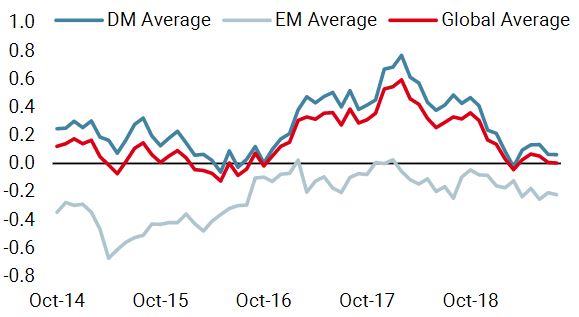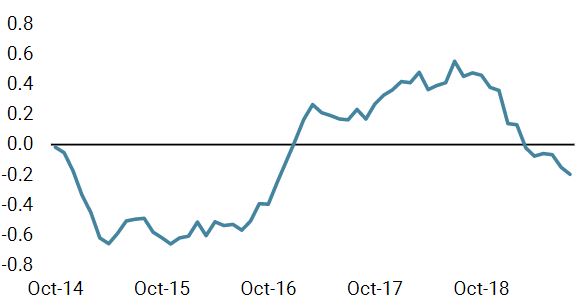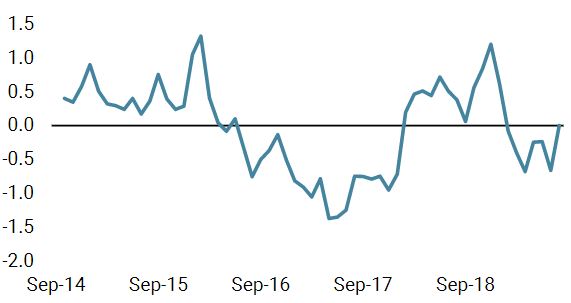July saw a continuation of the momentum in macro data and price action observed over the past few months. Economic growth is showing signs of fragile stabilisation, albeit with large divergences within and across regions. Disinflation, however, is more worrisome and has taken centre stage in central bankers’ minds as they now focus on trying to revive tepid growth and extend the economic cycle for as long as possible. Our assessment looks at the world from three different dimensions: macro, sentiment, and valuation. Equally important over the long run, it seems like the recent past has been all about monetary policy as a tool to push the next recession out further, and financial assets reaching new highs as investors thrive, listening to The Jolly Banker. Without a shadow of a doubt, global economic growth has taken a hit from largely above-potential levels observed in October last year. Since early 2019, our proprietary Growth Nowcaster has indicated a continuous decline, with a stabilisation around potential in March. Fast forward to July, the global level of growth has remained in check with divergences growing in the developed world. The Eurozone, Canada and UK have been showing continued signs of deceleration whereas the US economy has remained stable. It thus came as no surprise that the ECB recently ramped up its accommodative rhetoric to address this worrying situation. On average, the largest detractor remains production expectations, as uncertainty coming from trade tensions weighs on corporate optimism and investment.„THE JOLLY BANKER“ – Woody Guthrie, 1940
What’s Next?
Macro: Headwinds fought by the jolly bankers
No signs of improvement in inflation appeared on the horizon in July. Diffusion indices of our Inflation Nowcaster –indicating the dynamic of underlying data – dropped 10% to showcase a 60% deterioration in underlying data. This illustrates the negative inflation momentum most central bankers have acknowledged in recent declarations, and has been an important trigger behind their bid to tackle cross currents from the trade war and late cycle apathy. Inflation expectations have been the main drag globally while wage growth has been the main detractor in the US in spite of relatively strong job data abroad: the Phillips curve has not been repaired yet.
Central banks have therefore reacted firmly to stem economic decay and disinflationary forces. Response times were swift in turning less accommodative / hawkish stances back into supportive, easy monetary policies. In July alone, policy makers from Europe, Japan, Turkey, South Africa, Korea and the US all moved toward ample monetary support. This has been by far the most important factor in financial asset performance this year, and will continue to be until the next inflection point if, and when, macro fundamentals materially improve.
Optimism seemed to be everywhere up until the very last day of July, when the Fed delivered a somewhat “disappointing cut”. Broad measures of market sentiment had been pointing toward a low level of risk aversion and our Market Stress Nowcaster was no exception. The indicator fell back to low levels after a brief pick-up in May: credit spreads kept on tightening in all credit segments, volatility measures receded and liquidity improved as a result of CB easing. So far so good, but one could argue that sentiment was artificially maintained at very high levels by the jolly bankers. Indeed, under normal circumstances (traditional cycle and non-almighty policy makers) decelerating growth and heightened geopolitical tensions would weigh on sentiment, not buoy it. This is what we have been calling the “bad is good” situation for some time, where complacency becomes “legitimate” as long as the “central bank put” remains alive. Pragmatism remains key in this environment and it required effort not to reduce market exposure at a time when numerous assets have become substantially more expensive. In the meantime, headline risk remained elevated and resurfaced violently late last week on the back of hardening rhetoric between the US and China. The new threat of a 10% tariff on USD 300 Bn of Chinese goods and potential retaliation fears hammered risky assets and complacency in one go. Finally, “smart money” (CTA and Macro managers) has increased exposure to risky assets recently so the participation in the last leg of the rally has increased. Positioning in growth assets is not “light” any more and could soon become a source of concern as it is now hovering around October 2018 levels: high by historical standards but not yet extreme.Sentiment: Legitimate complacency?

This is the usual consequence of monetary policy accommodation: it creates richness – if not bubbles — and exuberance across asset classes. In fact, most risk premia are now flashing red when it comes to valuations. However, relative valuations paint an interesting picture: risky assets (equities and credit) are cheap relative to hedging assets (government and inflation linked bonds, precious metals). As a result, even if it is too early to call for a valuation crush, the expensiveness of hedging assets driven by the jolly bankers could have unpleasant consequences: correlation distortions and diminished protection if, and when, risk appetite reverses. Markets are currently dismissing the overall valuation factor for a good (or bad) reason. The outcome of such widespread expensiveness does not necessarily have to end in a drama in all risk premia but it would be naive to consider a broad-based multiple expansion as a sustainable environment. Stock valuations have a chance to cool down with a surge in earnings expansion, and credit spreads can keep on tightening as long as recession risk remains muted on the back of central bank action. Nevertheless, certain segments of the fixed income space seem materially over-priced, such as investment grade or government bonds. The current environment does not require a material and durable risk reduction, yet taking profit from large overweights made sense. As a result, beta reduction can be compensated by relative value opportunities, and our current preference is for credit carry, with a large long/short position in high yield against investment grade. Given the very low level of volatility, we have implemented a number of optional hedging strategies on equity indices to protect in case of an unexpected market shock.Valuation: Rich, but does it really matter?
Cross asset allocation: Reduced beta, increased carry

The Jolly Banker

Our medium-term views remain cautious, and we prefer to gain exposure to growth via high yield corporate credit. We are also complementing our modest equity exposure with options to protect the portfolio in case of equity drawdowns. Over the month of July, the Uni-Global – Cross Asset Navigator fund rose 1.2% versus 0.3% for the MSCI AC World Index and 0.8% for the Barclays Global Aggregate (USD hedged). Year-to-date, the Uni-Global – Cross Asset Navigator has returned 8.4% versus 16.6% for the MSCI AC World index, while the Barclays Global Aggregate (USD hedged) index is up 6.8%.Strategy Behaviour
Performance Review
Unigestion Nowcasting
World Growth Nowcaster

World Inflation Nowcaster

Market Stress Nowcaster

Weekly Change
- Our world Growth Nowcaster decreased this week, as most countries showed signs of slowing down.
- Our world Inflation Nowcaster decreased further this week. All countries but the UK saw their respective inflation nowcasters decrease.
- Market stress picked up as trade concerns escalated.
Sources: Unigestion. Bloomberg, as of 5 August 2019.
Past performance is no guide to the future, the value of investments can fall as well as rise, there is no guarantee that your initial investment will be returned. Important Information Past performance is no guide to the future, the value of investments, and the income from them change frequently, may fall as well as rise, there is no guarantee that your initial investment will be returned. This document has been prepared for your information only and must not be distributed, published, reproduced or disclosed by recipients to any other person. It is neither directed to, nor intended for distribution or use by, any person or entity who is a citizen or resident of, or domiciled or located in, any locality, state, country or jurisdiction where such distribution, publication, availability or use would be contrary to law or regulation. This is a promotional statement of our investment philosophy and services only in relation to the subject matter of this presentation. It constitutes neither investment advice nor recommendation. This document represents no offer, solicitation or suggestion of suitability to subscribe in the investment vehicles to which it refers. Any such offer to sell or solicitation of an offer to purchase shall be made only by formal offering documents, which include, among others, a confidential offering memorandum, limited partnership agreement (if applicable), investment management agreement (if applicable), operating agreement (if applicable), and related subscription documents (if applicable). Please contact your professional adviser/consultant before making an investment decision. Where possible we aim to disclose the material risks pertinent to this document, and as such these should be noted on the individual document pages. The views expressed in this document do not purport to be a complete description of the securities, markets and developments referred to in it. Reference to specific securities should not be considered a recommendation to buy or sell. Investors shall conduct their own analysis of the risks (including any legal, regulatory, tax or other consequences) associated with an investment and should seek independent professional advice. Some of the investment strategies described or alluded to herein may be construed as high risk and not readily realisable investments, which may experience substantial and sudden losses including total loss of investment. These are not suitable for all types of investors. To the extent that this report contains statements about the future, such statements are forward-looking and subject to a number of risks and uncertainties, including, but not limited to, the impact of competitive products, market acceptance risks and other risks. Actual results could differ materially from those in the forward-looking statements. As such, forward looking statements should not be relied upon for future returns. Targeted returns reflect subjective determinations by Unigestion based on a variety of factors, including, among others, internal modeling, investment strategy, prior performance of similar products (if any), volatility measures, risk tolerance and market conditions. Targeted returns are not intended to be actual performance and should not be relied upon as an indication of actual or future performance. Data and graphical information herein are for information only and may have been derived from third party sources. Unigestion takes reasonable steps to verify, but does not guarantee, the accuracy and completeness of this information. As a result, no representation or warranty, expressed or implied, is or will be made by Unigestion in this respect and no responsibility or liability is or will be accepted. All information provided here is subject to change without notice. It should only be considered current as of the date of publication without regard to the date on which you may access the information. Rates of exchange may cause the value of investments to go up or down. An investment with Unigestion, like all investments, contains risks, including total loss for the investor. Uni-Global – Cross Asset Navigator is a compartment of the Luxembourg Uni-Global SICAV Part I, UCITS IV compliant. This compartment is currently authorised for distribution in Austria, Belgium, Denmark, Finland, France, Germany, Ireland, Italy, Luxembourg, Netherlands, Norway, Spain, UK, Sweden, and Switzerland. In Italy, this compartment can be offered only to qualified investors within the meaning of art.100 D. Leg. 58/1998. Its shares may not be offered or distributed in any country where such offer or distribution would be prohibited by law. No prospectus has been filed with a Canadian securities regulatory authority to qualify the distribution of units of these funds and no such authority has expressed an opinion about these securities. Accordingly, their units may not be offered or distributed in Canada except to permitted clients who benefit from an exemption from the requirement to deliver a prospectus under securities legislation and where such offer or distribution would be prohibited by law. All investors must obtain and carefully read the applicable offering memorandum which contains additional information needed to evaluate the potential investment and provides important disclosures regarding risks, fees and expenses. All investors must obtain and carefully read the prospectus which contains additional information needed to evaluate the potential investment and provides important disclosures regarding risks, fees and expenses. Unless otherwise stated performance is shown net of fees in USD and does not include the commission and fees charged at the time of subscribing for or redeeming shares. Unigestion UK, which is authorised and regulated by the UK Financial Conduct Authority, has issued this document. Unigestion SA authorised and regulated by the Swiss FINMA. Unigestion Asset Management (France) S.A. authorised and regulated by the French Autorité des Marchés Financiers. Unigestion Asia Pte Limited authorised and regulated by the Monetary Authority of Singapore. Performance source: Unigestion, Bloomberg, Morningstar. Performance is shown on an annualised basis unless otherwise stated and is based on Uni Global – Cross Asset Navigator RA-USD net of fees with data from 15 December 2014 to 5 August 2019.Navigator Fund Performance
Performance, net of fees
2018
2017
2016
2015
Navigator (inception 15 December 2014)
-3.6%
10.6%
4.4%
-2.2%
